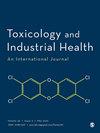金属和金属氧化物纳米颗粒的毒性主要针对肝细胞和肾细胞的线粒体
IF 1.7
4区 医学
Q3 PUBLIC, ENVIRONMENTAL & OCCUPATIONAL HEALTH
引用次数: 0
摘要
纳米粒子(NPs)被广泛应用于各种领域,对人类健康、组织、细胞和大分子构成潜在风险。本研究旨在探讨金属和金属氧化物 NPs 诱导的肝细胞和肾小管细胞的超微结构改变。将成年健康雄性 Wistar 白化大鼠(Rattus norvegicus)分为 6 个对照组(n = 7)和 6 个处理组(n = 7)。处理组的大鼠每天接触银氧化物、金氧化物、氧化锌氧化物、二氧化硅氧化物、氧化铜氧化物和氧化铁氧化物,为期 35 天。各相应 NPs 对照组的成员则接受相应的载体。对所有大鼠的肝脏和肾脏组织块进行透射电子显微镜(TEM)检查。所有经 NPs 处理的大鼠的肝细胞和肾小管细胞都出现了线粒体超微结构改变,主要是嵴溶解、肿胀、膜破坏、透明基质、基质溶解和电子致密沉积。然而,其他细胞器也表现出损伤,但程度较轻,表现为细胞核缩小、核膜凹陷、内质网破碎、细胞膜折叠、刷状缘微绒毛破坏、溶酶体增生、核糖体下降和过氧化物酶体形成。从这些发现中可以得出结论,肝细胞和肾小管细胞线粒体是纳米粒子毒性的主要目标,最终导致线粒体破坏和细胞损伤。需要进一步研究线粒体超微结构损伤与长期暴露于纳米材料导致的抗氧化防御系统减弱之间的关系。本文章由计算机程序翻译,如有差异,请以英文原文为准。
Metallic and metallic oxide nanoparticles toxicity primarily targets the mitochondria of hepatocytes and renal cells
Nanoparticles (NPs) are utilized in various applications, posing potential risks to human health, tissues, cells, and macromolecules. This study aimed to investigate the ultrastructural alterations in hepatocytes and renal tubular cells induced by metallic and metal oxide NPs. Adult healthy male Wistar albino rats ( Rattus norvegicus) were divided into 6 ( n = 7) control and 6 treated groups ( n = 7). The rats in the treated groups exposed daily to silver NPs, gold NPs, zinc oxide NPs, silicon dioxide NPs, copper oxide NPs, and ferric oxide NPs for 35 days. The members of the control group for each corresponding NPs received the respective vehicle. Liver and kidney tissue blocks from all rats were processed for Transmission Electron Microscopy (TEM) examinations. The hepatocytes and renal tubular cells of all NPs-treated rats demonstrated mitochondrial ultrastructural alterations mainly cristolysis, swelling, membrane disruption, lucent matrices, matrices lysis, and electron-dense deposits. However, other organelles demonstrated injury but to a lesser extent in the form of shrunken nuclei, nuclear membrane indentation, endoplasmic reticulum fragmentation, cellular membranes enfolding, brush border microvilli disruption, lysosomal hyperplasia, ribosomes dropping, and peroxisome formation. One may conclude from the findings that the hepatocytes and the renal tubular cells mitochondria are the main targets for nanoparticles toxicity ending in mitochondrial disruption and cell injury. Further studies taking into account the relation of mitochondrial ultrastructural damage with a weakened antioxidant defense system induced by chronic exposure to nanomaterials are needed.
求助全文
通过发布文献求助,成功后即可免费获取论文全文。
去求助
来源期刊
CiteScore
3.50
自引率
5.30%
发文量
72
审稿时长
4 months
期刊介绍:
Toxicology & Industrial Health is a journal dedicated to reporting results of basic and applied toxicological research with direct application to industrial/occupational health. Such research includes the fields of genetic and cellular toxicology and risk assessment associated with hazardous wastes and groundwater.

 求助内容:
求助内容: 应助结果提醒方式:
应助结果提醒方式:


